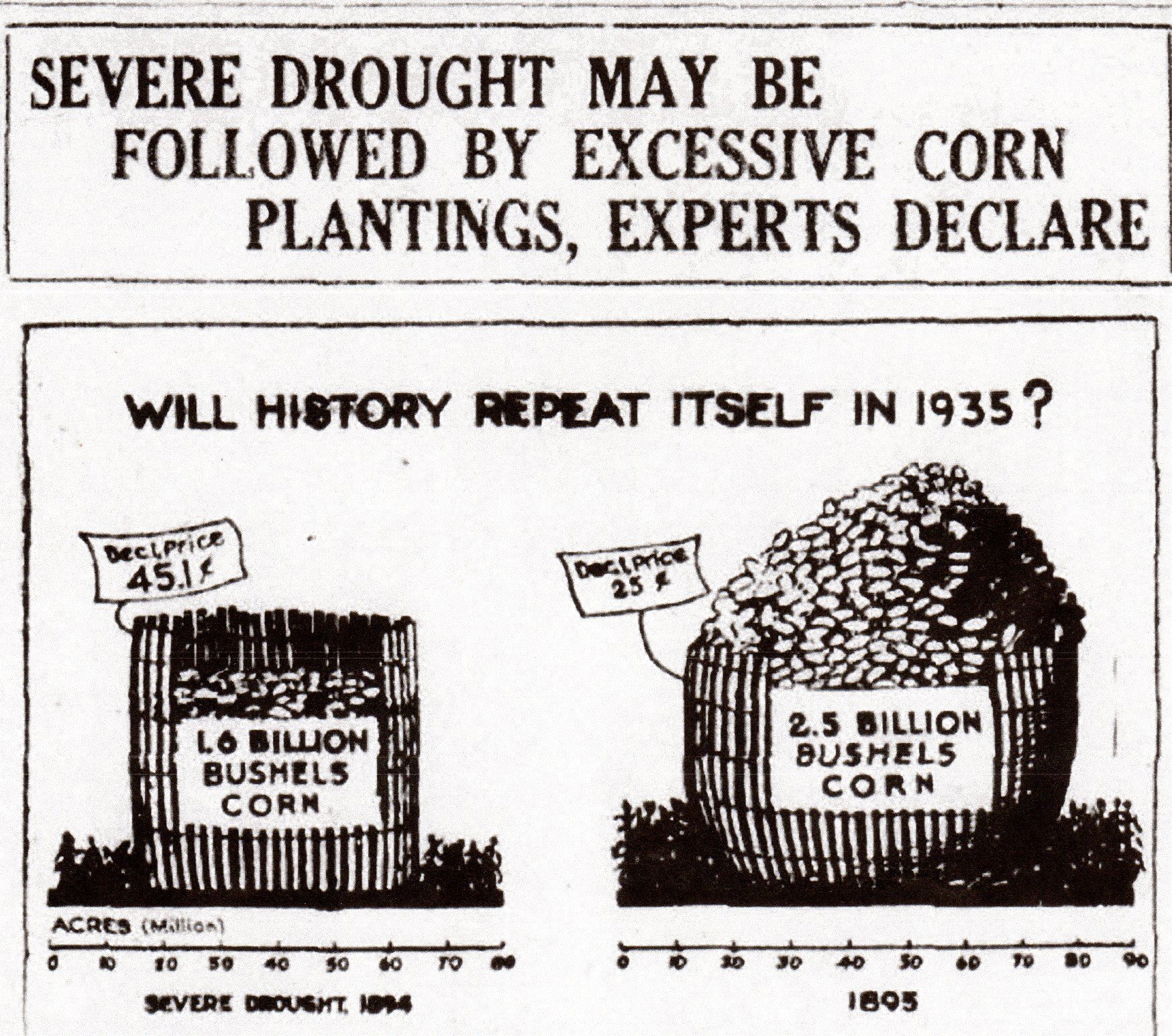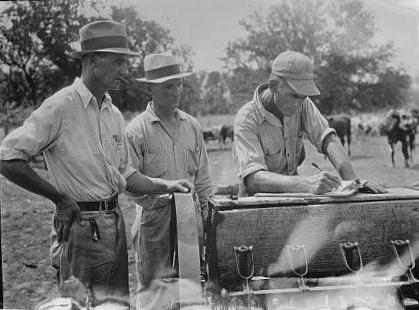The Drought of 1934

The drought of 1934 was just another difficulty to be faced by area residents living through the historic depression of the 1930’s. The stock market had crashed, banks had closed, business had laid off workers, and manufacturing had shut down. Farm prices went down, and farmers worried about keeping their farms. Although not considered part of the Great Plains Dust Bowl states, Adams County suffered a major drought. Personal reminiscences of those years were recently collected and given to the Historical Society of Quincy and Adams County. Many of those interviewed remembered the 1934 drought, particularly the dust and the heat. Sleeping on the porch or in the yard was the norm in the summer as no one had air conditioning. One family remembered they always had plenty to eat and said, “We didn’t have anything, but made the best of everything.” They remembered men going from farm to farm looking for work and housewives finding enough to feed them. Another talked about the importance of the harvest moons as they could work at night in the field, cutting corn stalks by the light of the moon.
The July 27, 1934 Herald Whig said the community was suffering from the highest temperatures and driest conditions ever reported. The Adams County farm advisor, S. F. Russell said the corn crop was a failure and he worried that the farmers would not have enough feed for their livestock. But he advised they not immediately sell their hogs and cattle as the prices were so low. In August, Adams, Brown, and Pike counties were the first in the state to be placed on the drought relief list of the Agriculture Adjustment Administration (AAA). Through the AAA Adams County farmers were able to participate in the government’s cattle buying program. Drought relief was one part of the AAA. The cattle they bought were processed and distributed to the “needy unemployed in Illinois,” according to the August 24th Herald Whig. Prices for two-year-old cattle ranged from $13 to $20 a head.
The 1934 drought also brought the Citizen’s Conservation Corps (CCC) to Quincy. Begun in 1933 and part of President Franklin Roosevelt’s New Deal, the Corps was a relief program which provided employment to single young men. Starting in the cities in the eastern United States, the program was expanded and in Illinois 5,581 men were to be recruited to work on emergency conservation in drought areas. Only drought affected counties and cities with a population of more than 2,500 were eligible to recruit men for the CCC. Quincy had a quota of 75 to fill.
The drought brought unexpected consequences to the county when the Illinois Department of Health announced there were 44 new cases of typhoid fever in Illinois with six cases from Adams County. The County had the second highest number of cases in Illinois. Water was scarce in 1934 and some were using old wells, cisterns, or creeks to get their water. Typhoid was one of the leading causes of death in the 19th century and the source was bacterial contaminated water or poor sanitation. The city health officer, Dr. H. O. Collins suggested people be vaccinated and advised country residents to get a supply of water from Quincy.
Both the state and Adams County had relief committees. The Illinois Emergency Relief Commission reported that Adams County led the state in the number and amount of drought loans. The average loan was $18 or $364.96 in today’s money. Loans were used to purchase livestock feed or seed for crops. W. P. Gerdes was the chair of the Adams County Emergency Relief Committee. He reported in the December 13th Herald Whig that the total number of drought loans to Adams County farmers was 1,219. “The loans, which could not exceed $200, Mr. Gerdes explained, could be paid back either in cash or labor, most of them being worked out by the borrowers on assignments made to various projects, such as the municipal airport, where men and teams have been working all fall on a drought relief assignment.” Others paid their loans back by working for their township road commissioner. The January 25, 1935 Herald Whig reported that as of November, 21.6% of Adams County residents were on the relief rolls.
By early 1935, the economic damage caused by the drought was considerable. The Adams County Shippers Association estimated the damage to be at least $6,000,000. There was practically no corn crop in 1934 so farmers had to buy corn at $1 per bushel. Hay, wheat and oats crops were also ruined. Cattle prices were up and those who still had cattle had to buy hay from other parts of the state and have the hay brought in, mostly by rail.
As reported in the February 26, 1935 Herald Whig, “Never in its history has Adams County faced such a shortage of hogs as this year, according to C. C. Mast, manager of the Adams County Shippers Association. Last year at this time the association was shipping out from six to eight cars of hogs a week, while this year the loaders are doing well to fill two cars weekly.” He predicted the shortage would last at least another year. When farmers realized they would have no feed for the winter after the 1934 summer drought, they sold their feeder hogs and brood sows. Mr. Mast told the Herald Whig that other parts of Illinois and Missouri were affected but not as badly as Adams and Pike counties. Across the county hog production was 35% of normal while cattle production fell 11%.
Farmers are uniquely affected by changing weather and there have certainly been periods of too much rain and not enough rain. But the drought of 1934 was significant enough to have been written about multiple times in the newspaper and to stay in the memoires of those who lived through it.
Sources
“Adams, Brown And Pike Counties Placed On Primary Drought Relief List; farmers Will Receive Help.” Quincy Herald Whig , August 14, 1934, 20.
“Adams County’s Hog Production is 75 Per Cent Short This Year: Drought Blamed For Situation.” Quincy Herald Whig , February 26, 1935, 12.
“Adams Has Lead in Relief Loans Made To Farmers.” Quincy Herald Whig, December 23, 1934, 7.
“Additional 75 May Be Sent To CCC Camp.” Quincy Herald Whig , July 9, 1934, 7.
“Claims Drought in Adams County Cost 6 Millions.” Quincy Herald Whig, March 10, 1935, 18.
“Greater Portion Drought Relief Loans Are Paid.” Quincy Herald Whig , December 13, 1934, 18.
“Illinois Moves To Reduce Cost Of Relief Work.” Quincy Herald Whig , January 25, 1935, 4.
“Quincy And Vicinity Has Not Had Heavy Rainfall Since June, 1933, More Than Year Ago, Records Reveal: Little Corn To Be Produced in County, Advisor says.” Quincy Herald Whig , July 27, 1934, 14.
“Send Out Blanks For Government On Cattle Sales.” Quincy Herald Whig , September 4, 1934, 7.
“Successful Year Shown In Report Of Farm Advisor.” Quincy Herald Whig , October 21, 1934, 6.
“Warns Against Typhoid Danger in Adams County.” Quincy Herald Whig , July 25, 1934, 10.
“Will Buy Cattle in Adams County As Relief Move.” Quincy Herald Whig , August 25, 1934, 12.







